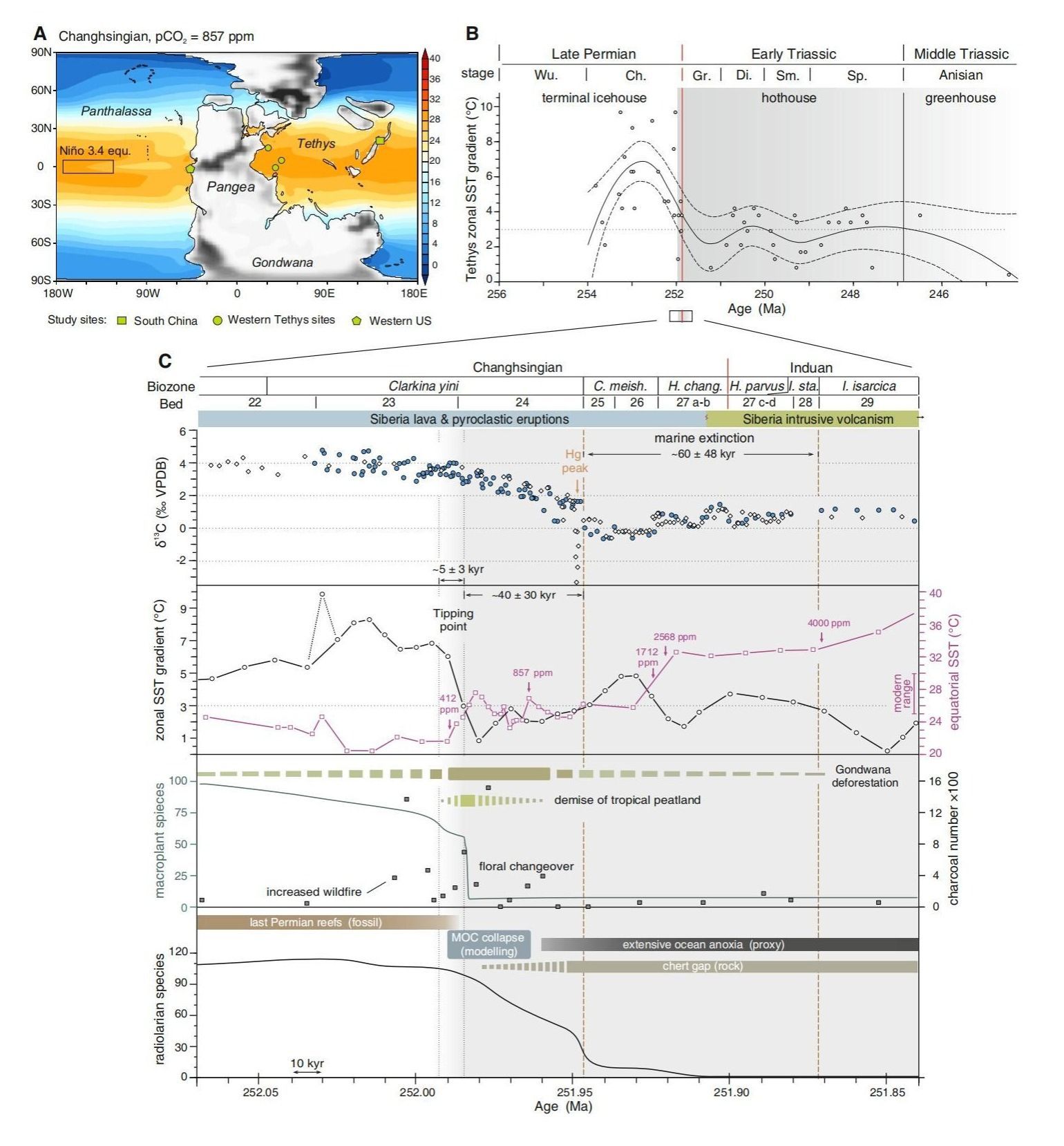The CUG research team, led by Prof. SUN Yadong from the State Key Laboratory of Biogeology and Environmental Geology, published their findings in the international top-tier journal Science on September 12th. The paper, “Mega El Niño instigated the end-Permian mass extinction”, using a systematic combined approach incorporating proxy data, Earth system modeling, and sedimentary observations on a global scale, establishs a model for critical atmosphere-ocean coupling during the end-Permian catastrophe and proposesa kill mechanism.
Of the >20 volcanism-driven hyperthermals that punctuate Phanerozoic history,only a few coincide with extinctions and none of them approaches the ~90% global species loss of the end-Permian.This challenges our understanding of Earth system tipping points.
There is a clear mismatch in kill mechanisms and timing between marine and terrestrial losses during the end-Permian mass extinction. Ocean deoxygenationis widely favored as a reason for marine losses; however, the impact of oceananoxia on land would have been minimal. None of the many causes, including wildfire, acid rain, ozone depletion, and metal poisoning, can fully explain the scale, spatial heterogeneity, or asynchronousnature of the end-Permian crisis.

Evolution of the low-latitude zonal SST gradient and summary of marine and terrestrial changes across the P-T transition.
Scant attention has been devoted to short-term climate oscillations occurring over interannual and interdecadal timescales in deeptime embedded within the context of longer-term climate change.The shift to a new climate state with enhanced variability at the end of the Permian was likely rapid. Using a Bayesian age model groundedin U-Pb dating, the transition is estimatedto have occurred within ~5±3kyr, predatingthe onset of marine extinction by ~40±30kyr. Because Late Permianmarine faunas maintained their diversity, it is generally thought that there were no environmental perturbations at this time. However, two-thirds of the volume of Siberian Traps lava and pyroclastic eruptions occurred before theextinction, and the study shows that they coincided with progressively enhanced ENSO (El Niño Southern Oscillation) activity. The initiation of a major crisis, encompassing deforestation on land, the collapse of MOC (Meridional Overturning Circulation), extinctions in marine plankton, and the demise of reefs, all occurred during the initial PCO2 doubling from 410 ppm to 857 ppm and coincided with a decrease in the equatorial zonal SST gradient in Tethys.
Thus, in the P-T world, even relatively small greenhouse gas emissions and warming were sufficient to tip the climate into a state characterized by prolonged and intense El Niño phases, and this introduced extremes in low-latitude temperature and precipitation that stressed terrestrial ecosystems. Drought intervals were too prolonged for trees to survive, strongly favoring opportunists among both plants and insects that were able to complete their life cycle during wet periods. In the ocean, plank tonic groups, with their subannual lifecycles, were also severely affected, but the resilience of the marine biosphere ensured its survival until it succumbed to progressive warming and ocean deoxygenation. The losses in biomass, in turn, reduced carbon sequestration, creating a warmer hothouse with stronger ElNiños.

Equatorial SST (Sea Surface Temperature) anomalies.
The ecological impact and future trajectory of extreme El Niños against a backdrop of global warming is not yet known. However, El Niño events today are known to cause coral bleaching and mass mortality of fish and birds.The Pangeansuper continent paleogeography was seemingly moresusceptible to ever-increasing ENSO events with increasing PCO2. The end-Permian crisis reveals that intensified ENSO increases the risk of extinction, enhancing low-latitude warmth that in turn created stronger El Niños. Consequently, the P-Ttransition saw the marine extinction lag by~40±30kyr, a short interval geologically and one that is alarmingly now on human time-scales as we move toward an ever more variable climate regime.
The article draws parallels between the past and the present, revealing that the environmental impacts of short-term climate variations are underestimated against the backdrop of overall climate warming. This provides references for human responses to increasingly variable modern climate change.
Link: https://www.science.org/doi/10.1126/science.ado2030
(Edited and translated from the Chinese version)